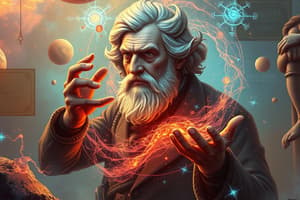Podcast
Questions and Answers
What is the electron cloud model?
What is the electron cloud model?
- A model that describes atoms as indivisible spheres
- A model that depicts electrons embedded in positively charged matter
- A model where electrons orbit the nucleus in defined paths
- A model where electrons surround the nucleus in clouds of probable locations (correct)
What is an emission spectrum?
What is an emission spectrum?
- A spectrum of wavelengths of light emitted by a substance (correct)
- A spectrum showing only the absorption wavelengths
- A method of measuring the intensity of light
- A general description of electromagnetic radiation
What is the photoelectric effect?
What is the photoelectric effect?
The process in which matter emits electrons as the result of absorbing light.
All of the proposed ideas by Dalton, Thompson, and Rutherford are still used in the Modern Theory of the Atom.
All of the proposed ideas by Dalton, Thompson, and Rutherford are still used in the Modern Theory of the Atom.
Which statements are part of the Early Atomic Theory? (Check all that apply)
Which statements are part of the Early Atomic Theory? (Check all that apply)
Does light shining on a strip of metal dislodge electrons more consistently suggest that light is made up of waves or particles?
Does light shining on a strip of metal dislodge electrons more consistently suggest that light is made up of waves or particles?
Which situations most likely produce a photoelectric effect?
Which situations most likely produce a photoelectric effect?
If a hydrogen electron is elevated from level 1 to level 2 and another is elevated from level 2 to level 4, which transition requires the greatest energy change?
If a hydrogen electron is elevated from level 1 to level 2 and another is elevated from level 2 to level 4, which transition requires the greatest energy change?
Which transition results in the emission of light with the greatest energy?
Which transition results in the emission of light with the greatest energy?
Identify each of the atomic models described here.
Identify each of the atomic models described here.
An electron's position cannot be known precisely. Only its probability of being in a certain location can be known. Which model does this describe?
An electron's position cannot be known precisely. Only its probability of being in a certain location can be known. Which model does this describe?
Electrons orbit the nucleus in specific, defined paths. Each path has a specified energy. Which model does this describe?
Electrons orbit the nucleus in specific, defined paths. Each path has a specified energy. Which model does this describe?
Electrons are embedded in a mass of positively charged matter. Which model does this describe?
Electrons are embedded in a mass of positively charged matter. Which model does this describe?
Describe the photoelectric effect and explain why it made modifications to the Rutherford model necessary.
Describe the photoelectric effect and explain why it made modifications to the Rutherford model necessary.
What is the main difference between the Bohr model of the atom and the Rutherford model?
What is the main difference between the Bohr model of the atom and the Rutherford model?
Flashcards are hidden until you start studying
Study Notes
Modern Atomic Theory Concepts
- Electron Cloud Model: Protons and neutrons form a dense nucleus; electrons exist in clouds indicating probable locations around the nucleus.
- Emission Spectrum: Displays emitted wavelengths as colorful lines against a dark background, unique to each element.
- Photoelectric Effect: Describes how materials release electrons upon absorbing light.
Historical Models and Theories
- Early Atomic Theory: Atoms are indivisible; combine in whole ratios to form compounds; cannot be created or destroyed in reactions.
- Dalton's Model: Describes atoms as indivisible spheres.
- Plum Pudding Model: Suggests electrons are embedded in positively charged matter.
- Bohr Model: Electrons occupy defined energy levels with specific paths around the nucleus.
Key Differences Between Models
- Bohr vs. Rutherford:
- Rutherford allows free electron locations; Bohr restricts them to defined energy levels.
- In the Bohr model, energy levels correlate to specific emissions.
Energy Transitions and Light Emission
- Light emission occurs when electrons drop between energy levels, with transitions from higher to lower levels releasing energy proportional to the energy difference.
- The transition from level 4 to level 2 produces the highest energy light emission.
- The photoelectric effect indicates that specific light wavelengths are needed to eject electrons, thus modifying previous atomic models.
Photoelectric Effect Observation
- Electrons are emitted only at specific photon energies, contradicting the notion that intensity alone governs electron release.
- Blue light, with higher energy, is more effective than red in causing the photoelectric effect.
Unique Elements and Energy Levels
- Each element has a distinct emission spectrum due to unique energy levels.
- The Bohr model explains this by correlating electron transitions to specific emitted wavelengths based on energy differences.
Studying That Suits You
Use AI to generate personalized quizzes and flashcards to suit your learning preferences.




